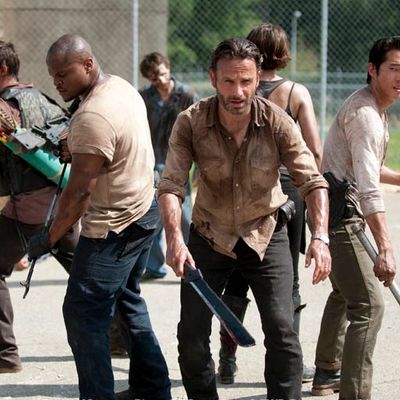
The Walking Dead is finally coming to life, and itÔÇÖs about time.
AMCÔÇÖs zombie drama, which kicks off its third season tonight, showed potential early on ÔÇô the pilot had a fine, spooky mood, and the first few episodes after that had their moments ÔÇô but it soon got bogged down in endless discussions about psychology, morality and the social compact. The problem wasnÔÇÖt that The Walking Dead cared about such things ÔÇô all zombie tales do, just as all Westerns care, to some degree, about the ideas of ÔÇ£the frontierÔÇØ and so-called civilization; it was that the characters were so flat and the dialogue so clunky that every conversation sounded like a college paper on themes that would have been better articulated through action anyway.
By the time the characters settled into that farmhouse in season two, the show had become laughably trite and tedious ÔÇô a mediocre daytime soap interrupted by zombie attacks. When you watch the scene in 28 Days Later where Brendan GleesonÔÇÖs dad battles the filmÔÇÖs ÔÇ£rage virusÔÇØ and his loved ones look on in horror, coming to grips with the fact that theyÔÇÖll have to kill him, you donÔÇÖt need dialogue to know whatÔÇÖs at stake: love and empathy versus utilitarian coldness. You get it; how can you not, if you have eyes, ears and a brain?
I never thought IÔÇÖd say this, considering how much I like his feature film work, but the departure of series executive producer Frank Darabont (The Shawshank Redemption, The Mist) seems to have improved the show. Towards the end of season two, The Walking Dead (finally) embraced its own genre. It wasnÔÇÖt trying to class up the zombie saga; it was content to find the Art in pulp by being artfully pulpy ÔÇô by telling the story as directly as possible. Pivotal moments that once would have been articulated in a starchy three-minute conversation were handled with an exchange of glances, a silent close-up, or a brazenly iconic image, such as that shot of Rick and his son silhouetted in the barn loft like characters from an 1950s Technicolor Western. The first two episodes of season three continue in this vein. TheyÔÇÖre relaxed, assured and a pleasure to watch (despite the gore). They donÔÇÖt avoid this showÔÇÖs, indeed every showÔÇÖs, biggest pitfall: a meandering, drawn-out quality that doesnÔÇÖt so much embrace TVÔÇÖs aesthetic freedom as wallow in it. But this is, for now, a churlish complaint. The Walking Dead is so much better now that IÔÇÖm willing to watch patiently and see where it goes from here. (Warning: Mild spoilers from here.)
As pure filmmaking, the first five minutes of tonightÔÇÖs premiere might be the showÔÇÖs best five minutes to date. Rick, Daryl, Maggie, Lori, T-Dog and the other characters (including young Carl, wearing his dadÔÇÖs trooper hat and handling a gun with aplomb) clear a farmhouse of walkers. ItÔÇÖs a slow, quiet but brutal sequence, with just one syllable spoken. ItÔÇÖs bold yet relaxed, not a combination of qualities you see very often on so-called ÔÇ£quality television,ÔÇØ which more often wears its art on its sleeve. I found myself paying more attention to the showÔÇÖs environment than ever before and thinking about the practical realities of post-apocalypse life: the fact that you have to boil water before you drink it, and that thereÔÇÖs no shame in eating dog food as long as itÔÇÖs not expired.
Here and in the rest of the episode ÔÇô which shows Rick and company taking over a zombie-infested prison that will serve as one of season threeÔÇÖs main locations ÔÇô you get a sense of how much this world has changed. The characters donÔÇÖt talk about their feelings as much because theyÔÇÖre numb now. Killing┬á (if thatÔÇÖs the right word for exterminating the undead) has become a morally neutral skill, like the ability to repair a car or make a campfire. We get it. ItÔÇÖs there onscreen, encoded in the action.
Ernest Dickerson, who directed this episode, used to be a cinematographer. He brings that skill set to bear in an extended, X-Files-like sequence of the heroes clearing a dark cellblock, their flashlight beams cutting through the gloom. Most of the time you hear more than you see. The horrors (maimed corpses, growling walkers) are more potent for being briefly glimpsed. You also get a sense of how much Rick has changed simply by watching him push his comrades to the limits of their endurance. HeÔÇÖs much harder and colder now. His Dudley Do-Right earnestness is MIA. When Lori ÔÇö whoÔÇÖs carrying around the worst fake-pregnant belly in recent TV history ÔÇö tries to have a for-old-timeÔÇÖs-sake conversation about The Issues Facing Their Relationship, he begs off, because thereÔÇÖs so much work to be done. Or maybe he just says that because he dreads the arrival of a baby that was possibly fathered by his late frenemy, Shane. There are a couple of deft scenes featuring Michonne, the sword-toting badass who saved Andrea from walkers in the season finale. These, too, have an old Western quality. TheyÔÇÖre tough and terse, and Michonne seems as casually mythic as Toshiro MifuneÔÇÖs scruffy ronin in Yojimbo.
This is all compelling enough that you might not realize until the very end of the first episode that youÔÇÖve seen an hour of dramatic throat-clearing, and that the prison assault (and introduction of new characters) could have been compressed into one elegant montage. ThereÔÇÖs still a sense that The Walking Dead is shambling along too lackadaisically. Great pulp is propulsive, ruthless. But the showÔÇÖs embrace of ÔÇ£BÔÇØ-movie values is a heartening sign. This is a very bleak world, and it demands a tougher outlook. To quote the sherriff in George RomeroÔÇÖs original Night of the Living Dead, ÔÇ£if you got a gun, shoot ÔÇÿem in the head. ThatÔÇÖs the sure way to kill ÔÇÿem. If you donÔÇÖt, get yourself a club, beat ÔÇÿem or burn ÔÇÿem. They go up pretty easy.ÔÇØ


